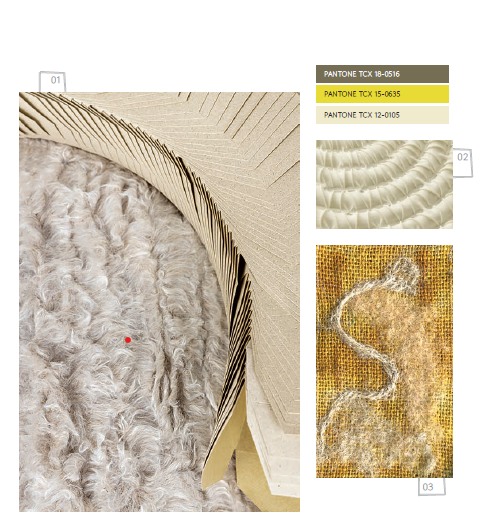 Heimtextil Trend Board approached their 24/25 textile trends differently: from trends being the driver to transformation being the driver. The focus of Heimtextil’s 24/25 edition is addressing change at scale by presenting different transformative textile innovations under the headline New Sensitivity.
Heimtextil Trend Board approached their 24/25 textile trends differently: from trends being the driver to transformation being the driver. The focus of Heimtextil’s 24/25 edition is addressing change at scale by presenting different transformative textile innovations under the headline New Sensitivity.
New Sensitivity transforms broadly and deeply and invites us to consider what we bring into the world and how it can contribute to a balanced nexus with the hope to inspire, leave an impact, and thus accelerate the fundamental transformation for the home textiles industry.
Sensitivity often relates to touch, sensation, and spirituality, but it is also about showing consideration, empathy and respect. In this context, sensitivity means considering the impact when making a decision or creating a product. Understanding how natural ecosystems work and prioritizing balance as the default are key to maintaining a sensitive way of working. Another underlying aspect to understanding New Sensitivity is solidarity. This solidarity means considering our relationship with each other, technology, and nature as linked and functioning as a nexus. The three areas – nature, technology, and people – are undergoing significant transformation, and each affect and reinforces the other. New Sensitivity, encourages the textile community to address the future thoughtfully and with consideration and to embrace New Sensitivity in home textiles.

Specifically, we are seeing this shift occur across three different approaches to a more sensitive world of textiles: bioengineered, plant-based and technological. All three directions show different pathways. The bioengineered way leverages the power of nature by engineering natural ingredients for use in the textile world while maintaining a close relationship with nature’s atomic origins. The plant-based process showcases new ways of creating textiles from sustainable and resilient plants or by-products of plant growth. Meanwhile, the technological method illustrates how technology can support the transformation of textiles in more circular ways, reduce environmental impact and improve human well-being.
COLOR

A sensitive approach to coloring methods is expressed by a dynamic yet subtle color palette created through natural pigments deriving from the earth, as traditional coloring processes are brought to the next level through innovative bioengineering technology. In pursuit of creating colors that evoke emotions in our senses while at the same time respecting our values in protecting the environment. This New Sensitivity includes acceptance of natural color flows, as colors may fade with time or morph into new colorways.

Bio Engineering

To a certain degree, bio-engineered textiles represent a fusion of plant-based and technological textiles. Bio-engineering bridges nature and technology and transforms the way textiles are made. They can be divided into two directions: fully bio-engineered and biodegradable textiles. In the production of fully bio-engineered textiles nature-inspired strategies are adopted. Instead of growing plants and extracting their fibers, textiles are made from the protein, carbohydrates, or bacteria in corn, grass, and cane sugar. Manufacturing involves a bio-molecular process that creates filaments which are made into yarn. The sustainable advantage of bio-engineered textiles is that they can have some of the same functionalities as synthetically produced textiles, while still being biodegradable because of their natural origin.
Technology and Textiles
 Technology can support the transformation of textiles through the use of different methods: upcycling and recycling of textiles, textile construction, and textile design. Due to decades of production, textiles are now a material we have in abundance. Developing technologies for recycling textile waste and methods for upcycling textiles increases the circular usage of existing textiles and thus reduces the need for virgin production. Furthermore, old textile construction techniques also offer pathways to sustainable solutions: For instance, using knitting technology instead of weaving for furniture upholstery produces less fabric waste. Alternatively, weaving allows the creation of several colors using only a few colored yarns. Textile Design Thinking is another method that addresses critical issues such as energy usage and durability of natural fibers and enhances these through technological textile advancement.
Technology can support the transformation of textiles through the use of different methods: upcycling and recycling of textiles, textile construction, and textile design. Due to decades of production, textiles are now a material we have in abundance. Developing technologies for recycling textile waste and methods for upcycling textiles increases the circular usage of existing textiles and thus reduces the need for virgin production. Furthermore, old textile construction techniques also offer pathways to sustainable solutions: For instance, using knitting technology instead of weaving for furniture upholstery produces less fabric waste. Alternatively, weaving allows the creation of several colors using only a few colored yarns. Textile Design Thinking is another method that addresses critical issues such as energy usage and durability of natural fibers and enhances these through technological textile advancement.
Plant Based Textiles
 Plant-based textiles mean that the fibers are derived from something that grows rather than being produced. The sustainable advantage of plant-based textiles is that their origin is natural and, therefore, more able to recirculate in existing ecosystems. They can be divided into two groups. The first group of textiles are made from plant crops. New resilient crops like cactus, hemp, abaca, seaweed, and rubber offer new sustainable textile solutions. Because of mechanical extraction, they can grow despite climate changes and require fewer chemicals in their development. The second group consists of textiles made of plant by-products which are leftover raw materials from production such as banana, olive, persimmon and hemp.
Plant-based textiles mean that the fibers are derived from something that grows rather than being produced. The sustainable advantage of plant-based textiles is that their origin is natural and, therefore, more able to recirculate in existing ecosystems. They can be divided into two groups. The first group of textiles are made from plant crops. New resilient crops like cactus, hemp, abaca, seaweed, and rubber offer new sustainable textile solutions. Because of mechanical extraction, they can grow despite climate changes and require fewer chemicals in their development. The second group consists of textiles made of plant by-products which are leftover raw materials from production such as banana, olive, persimmon and hemp.
Future Materials
 We are beginning to look beyond sustainability to regenerative design – but what does this really
We are beginning to look beyond sustainability to regenerative design – but what does this really
mean and how do we define regenerative textiles and materials? With human activities already causing major harm to the planet, current efforts around sustainability don’t go far enough to tackle the environmental crisis we are facing. Regenerative design is committed to putting back better – creating holistic creative practices that restore or renew resources, leave a positive environmental impact and help communities thrive.
For Heimtextil 2024, design futures consultancy FranklinTill is curating a global showcase of cutting-edge textiles and materials to illustrate the principles of regenerative design. By celebrating pioneering designers, producers and manufacturers at the forefront of regenerative design, we can facilitate and accelerate change, enabling both people and the planet to flourish.















Wow, it is wonderful to read how advanced the textile world is in taking on the challenges we are facing and creating products that are so sensitive to the environment and our natural resources. Thanks for the wonderful recap..